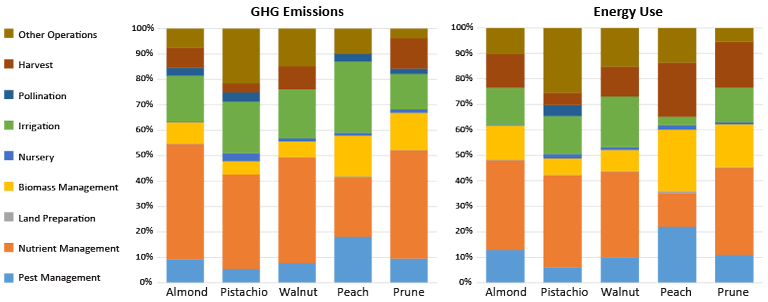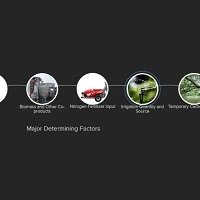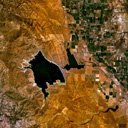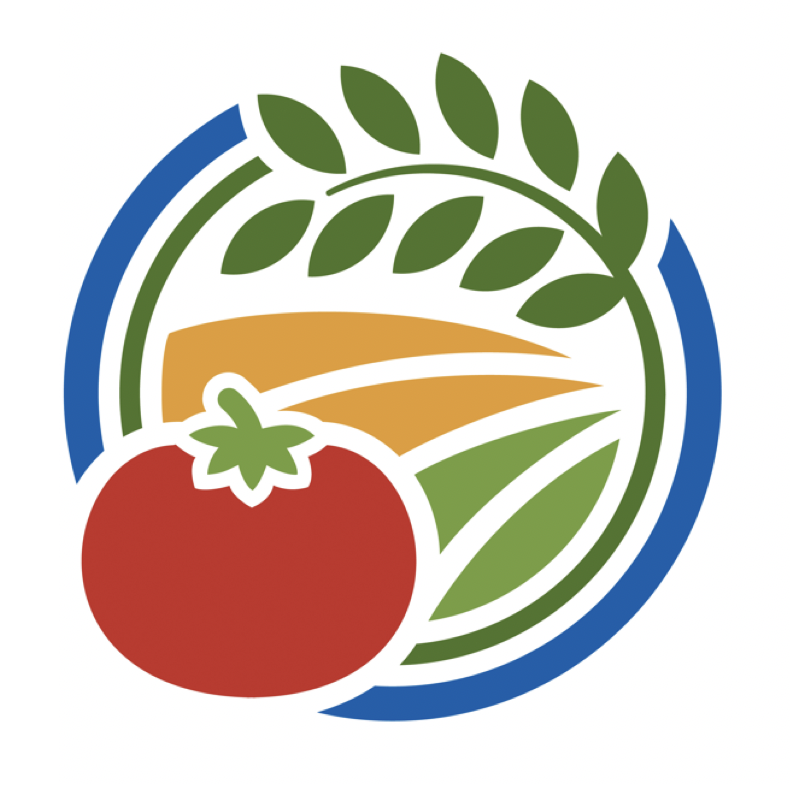This study calculated the GHG emissions, energy use, on-farm water use and six common air pollutants linked to the production of five orchard crops, and considered production stages from orchard establishment through management, post-harvest processing, and orchard removal and disposal. Transportation along the entire orchard life cycle was also included.
LCA models can be used to compare the impacts of different scenarios. This model evaluated the impacts of different sets of orchard management practices, in order to inform orchard industry decision makers about the best options for mitigating GHG emissions.
Summary of Findings
Key sources of GHGs were found in both industrial systems (e.g. diesel combustion, heat and energy sources for processing facilities, agrochemical production) as well as on-farm biogeochemical sources (in the form of nitrous oxide emissions from soil microorganisms responding to nitrogen fertilizers).
- The LCA found that the largest GHG and energy footprint was associated with the orchard management phase of production, while transportation of inputs and products to and from the farm had the smallest energy cost. Therefore, the greatest potential for lowering GHG emissions is achievable by focusing on alternative management choices.
- Across all five orchard systems, either nutrient management (including production and application of fertilizer) or irrigation accounted for the most GHG emissions. Nutrient management accounted for up to 40% of life cycle GHG emissions, while irrigation accounted for up to 20% of emissions, depending on the crop. This indicates that increasing nitrogen use efficiency and improving irrigation efficiency could significantly reduce emissions.
- Open burning of orchard waste is another major emitter of GHGs. Alternative methods of tree and pruning disposal, such as chipping the trees and incorporating the biomass back into the soil, can dramatically decrease GHG emissions.
- When comparing the five orchard crops, the determining factors that most influence the relative size of the net GHG footprint per unit of crop output include the following: amount of nitrogen fertilizer input, quantity and source of irrigation water, orchard lifespan, utilization of co-products such as orchard biomass outside of the orchard, magnitude of temporary carbon storage possible in trees and soil, and crop yield.
- Within the same crop, results can vary substantially according to geographic region, especially due to the high variability of irrigation energy intensity in different parts of the Central Valley.

Proportion of total footprint accounted for by each of 9 management categories for almond, pistachio, walnut, peach, and prune (based on a per acre analysis, and not accounting for any credits from use of co-products)
Major Determining Factors in GHG Emissions and Energy Use |
Regional Differences in Irrigation Energy Use |
|---|---|

Six major determining factors play the largest role in determining the relative magnitude of GHG footprints of the different orchard crops. Use this interactive map to explore project results for each of the five crops.
|

Because of factors like proximity to water delivery infrastructure and depth to groundwater, energy used in irrigation varies widely across regions of California.
|
Management categories used in this LCA
To aid in identifying specific "hot spots" of GHG emissions and energy use in orchard crop production, this study examined ten management categories as components of the total footprint.
|
Management categories |
|
|---|---|
|
Land preparation includes all equipment operations needed to prepare a site for a new orchard, including ripping, disking, and making berms. |
Nutrient management includes the manufacture of fertilizer, distribution to retail, transport to orchards, field application, and soil N2O emissions. |
|
Pest management includes manufacture of pesticides (insecticides, herbicides and fungicides), distribution to retail, transport to orchards, and field application (including fumigation). |
Irrigation includes sourcing of surface and groundwater according to proportions used in different parts of the state (both of which may require pumping, depending on location in the state), and pressurization for micro-irrigation systems. |
|
Pollination includes annual feeding of bees, annual hive maintenance and annual transport of hives to orchards, in proportion to the relative income accruing to beekeepers from pollination services versus honey production. |
Biomass management includes any equipment use for annual shredding or chipping of prunings, and equipment use for whole tree removal at the end of the orchard’s lifespan, including chipping and transport to biomass power facilities. |
|
Harvest includes equipment use for harvesting product (including sweeping and windrowing, if necessary) and transporting to farm gate. |
Nursery includes all equipment operations, nutrient and pest management, irrigation required to produce saplings in a nursery, and transport of materials to orchard. |
|
Other operations include miscellaneous activities required for orchard monitoring and maintenance, especially driving of pick-up trucks and ATVs. |
Post-harvest operations include hulling and shelling (almonds and walnuts), washing and drying (prunes), and washing and sorting (peaches). |
